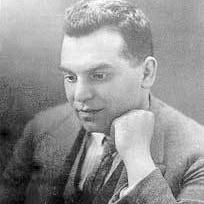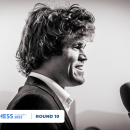Richard Reti

Bio
Richard Reti was among the best chess players in the world during his prime. In fact, he famously beat three of them in the great New York 1924 chess tournament—ending current world champion Jose Raul Capablanca’s eight-year winning streak, taking down future world champion Alexander Alekhine, and beating Efim Bogoljubov, who later became the first FIDE world champion, in his prime.
Two of those victories came with Reti employing the opening he created the previous year. And, to put it lightly, the Reti Opening would revolutionize the game. Plenty of top players didn’t respect it and the hypermodern principles it thrust into the spotlight, but it didn’t take long for them to implement both.
Reti was a chief proponent of the hypermodernism school of chess, which he examined the beginnings of in his classic 1921 book, Modern Ideas of Chess. He also wrote another highly regarded book, Masters of the Chess Board, and was an active chess journalist. Additionally, Reti composed some of the finest endgame studies available.
- Playing Style
- Early Career (1901 To 1917)
- Emergence As A Top Player In The World (1918 To 1920)
- Contributions On And Off The Board (1921 To 1926)
- Return To The Top (1927 to 1929)
- Legacy
Playing Style
Early in his career, Reti favored aggressive openings and tactical positions. Here he sacrifices a full piece in a line of the King’s Gambit and later (move 15) unleashes a devastating combination.
Later, of course, Reti switched to hypermodern openings and favored a more positional approach. His tactical background comes in handy when converting a lasting positional advantage, as he shows in this masterpiece against Akiba Rubinstein.
Add a love of endgame from his composed studies, it’s easy to see why Reti was such a great player. He had no real weakness and could thrive in any aspect of the game.
Early Career (1895 To 1917)
Reti learned how to play chess at the age of six. According to a memoir by Rudolph Reti, his older brother, the young Richard simply watched Rudolph and his father play before asking to join. His father balked at the notion, but after the young child started, the request was granted—and the future chess legend then promptly beat his father twice in a row. He said he had watched them play and learned from their mistakes.
As a 12-year-old, Reti submitted a chess problem to a publication and the next year had the honor of meeting the legendary Carl Schlechter, who helped Reti get into leading Viennese chess club Wiener Schachklub. It helped spark his passion for chess, and a few years later, he entered competitive chess by placing seventh in the Hungarian national tournament in 1907.
A friendship with future Hungarian national champion (in 1912) Gyula Breyer helped Reti increase his strength drastically. It translated to plenty of success in strong local tournaments in Vienna and a fourth-place showing at the King’s Gambit Accepted themed tournament in Abbazia in 1912.
The outbreak of World War I halted any prospect of international chess, but it seemed to have a positive impact on Reti’s rapid ascension to the top.
Emergence As A Top Player In The World (1918 To 1920)
Reti won the strong Kassa tournament in 1918 over the likes of Breyer, Schlechter, and Jacques Mieses. Then he shared first that year in Budapest.
Around this time, Reti still viewed chess as a hobby. His intention was to complete his doctoral thesis in mathematics, but Reti lost the document. It nearly drove him to suicide. However, soon afterward, he received an offer from Holland to be a chess master in residence that he accepted. Chess dominated his life from that point.
Reti won at Rotterdam 1919, Amsterdam 1920, and Vienna 1920. Then came success at the tournament at Gothenburg in 1920, which was the first strong international tournament where Reti could claim success. He almost never had a chance to do so. At that time, Reti wasn’t accepted by some as a top-tier player; Siegbert Tarrasch even filed a formal complaint to move Reti and Breyer to the lesser tournament.
Reti won the first-class tournament with 9.5/13 points. He topped Tarrasch as well as the likes of Rubinstein, Bogoljubov, Mieses, and Aron Nimzowitsch. Reti was firmly in his prime and a threat to any player, as he continued to demonstrate in the next phase of his young chess career.
Contributions On And Off The Board (1921 To 1926)
Reti took a brief detour from top chess at this point in his career. He became less active as a player in 1921 because he, in the words of Harry Golombek in Richard Reti’s Best Games, “had fallen victim to a disease that is often fatal to a chess master—he had become a chess journalist.”
In addition to working as a regular columnist for Austrian and German newspapers, he wrote Modern Ideas in Chess in 1921. That year he also composed his most famous endgame study (the first position in this interactive collection of Reti’s studies).
Reti returned to active play in 1922 and participated in nearly all of the great tournaments. He shared first place with Rudolf Spielmann at Teplitz-Schonau (1922) against at least five of the world’s top-10 players. He took clear second both at Mahrisch-Ostrau (behind only Emanuel Lasker) and Vienna (behind Savielly Tartakower) in 1923, the same year he introduced the world to the Reti Opening. At the epic New York 1924 tournament, Reti took down Capablanca and his eight-year winning streak (and his first loss as world champion), while winning against Alekhine and Bogoljubov.
In 1925 Reti went to Brazil for a prolonged stay. There he set a world record at the time for blindfold chess with 29 games played simultaneously (21 wins, two losses, and six draws). Alekhine is recorded as saying that he and Reti were clearly the best blindfold players in the world. When Reti returned to Europe that year, he had a bit of a setback in his play, perhaps as a result of his prolific output as a journalist.

From this point, he was actively engaged in his endgame studies.
Return To The Top (1927 to 1929)
Reti regained form in 1927. He placed second at Bad Homburg (behind Bogoljubov) and scored well as the top board for Czechoslovakia at the International Team Tournament.
Then in 1928, he did even better with first-place finishes at both Vienna and Giessen. Next Reti headed to Scandinavia for a tour of simultaneous displays in Sweden and Norway. From late December 1928 to January 1929, he won in Stockholm what would be his last tournament. Reti then returned home to work on Masters of the Chess Board, which he never finished and was published posthumously in 1933.
In June 1929, a little more than a week after turning 40, Reti died from scarlet fever.
Legacy
There’s no doubt that Reti was among the best players in the world, which is quite a feat with the likes of Lasker, Capablanca, Alekhine, Nimzowitsch, Tarrasch, Bogoljubov, Rubinstein, and several others in the mix. That alone is an incredible accomplishment for a player who didn’t really view chess as his calling until around age 30—10 years before his death.
But it’s only the start to his legacy as a chess giant. He authored two classics, influenced European and even Soviet chess through his journalism, pioneered the opening phase of the game, helped introduce the world to hypermodern chess, and left behind dozens of beautiful endgame studies.
He may not have won a world championship and thus may not be a household name for some chess fans, so to speak, but none of that detracts from his legacy.


